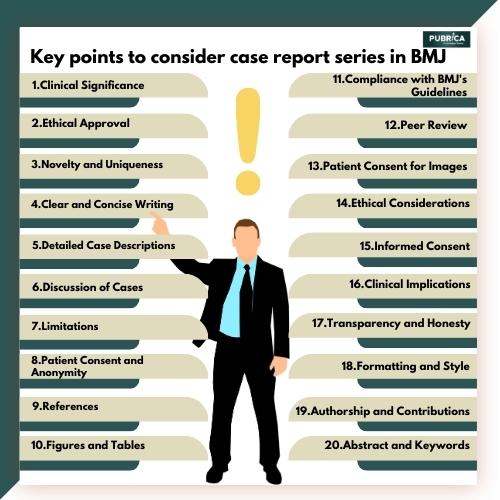
How Randomized Controlled Trials are Used in Meta-Analysis
November 8, 2023
What are the different epidemiological studies that can be conducted in respiratory research?
November 23, 2023In brief
Case reports and case series are uncontrolled study designs with a high risk of bias, yet they have had a significant impact on medical literature and continue to expand our understanding. We offer essential points and applications of evidence gathered from case reports and case series in this blog. We suggest assessing the methodological quality of scientific case reports and case series using the areas of selection, ascertainment, causation, and reporting, as well as providing signalling questions and systematic reviewers.
Case report series in BMJ
BMJ Case Reports is an online resource that contains many peer-reviewed cases from many disciplines, making it easy for healthcare practitioners, academics, and others to obtain clinically essential information about common and unusual disorders.
In the context of the BMJ, case report series are likely to adhere to the journal’s guidelines for submission. Authors are typically required to provide detailed information about each case, including patient demographics, clinical presentation, diagnostic methods, treatment approaches, and outcomes. The purpose is to contribute to medical knowledge, share unique or rare cases, and offer potential guidance for clinical practice.
- To know more about case-report services, check our study guide on What are the Guidelines for Writing a Case Report?

Key points
When considering submitting a case report series to BMJ (British Medical Journal), it’s important to keep in mind the following key points:
- Clinical Significance: Ensure that your case report series addresses an important clinical issue or provides valuable insights into a particular condition, treatment, or clinical practice.
- Ethical Approval: Confirm that your study has obtained the necessary ethical approvals and patient consent, adhering to ethical standards and patient privacy regulations.
- Novelty and Uniqueness: Highlight the novelty and uniqueness of your case series. Explain how your cases contribute to the existing medical literature or offer new perspectives.
- Clear and Concise Writing: Write your case report series clearly and concisely. Use structured headings and subheadings to organize the content, making it easier for readers to follow the narrative.
- Detailed Case Descriptions: Provide comprehensive descriptions of each case, including patient history, clinical presentation, diagnostic methods, treatments, and outcomes. Include relevant images or diagnostic tests.
- Discussion of Cases: Analyze and discuss the cases in the context of the current medical literature. Explain how your findings contribute to the understanding of the condition or treatment.
- Limitations: Acknowledge the limitations of your case report series, including potential biases, small sample size, or other relevant issues.
- Patient Consent and Anonymity: Ensure that patient anonymity is preserved and patient consent for publication is obtained. Follow BMJ’s guidelines on patient consent and confidentiality.
- References: Cite relevant and up-to-date references to support your medical case series and discussion. Follow BMJ’s referencing style.
- Figures and Tables: Use figures, tables, and images to illustrate key points in your case series. Ensure they are of high quality and well-labelled.
- Compliance with BMJ’s Guidelines: Familiarize yourself with BMJ’s specific guidelines for case reports and ensure your submission adheres to their formatting, referencing, and other requirements.
- Peer Review: Be prepared for the peer review process. Reviewers may provide feedback and suggestions to improve the quality and clarity of your case report series.
- Patient Consent for Images: If your case report includes images of patients, obtain explicit consent for the publication of those images and respect patient privacy.
- Ethical Considerations: Discuss any ethical dilemmas or considerations that arose during the course of your study or in the management of the cases.
- Informed Consent: Clearly describe how informed consent was obtained from patients or their legal representatives.
- Clinical Implications: Discuss the clinical implications of your findings and how they may influence patient care or medical practice.
- Transparency and Honesty: Be transparent and honest in presenting your case report series. Avoid exaggeration or overinterpretation of results.
- Formatting and Style: Follow BMJ’s formatting and style guidelines for case reports to ensure your submission meets their requirements.
- Authorship and Contributions: Clearly define the contributions of each author and ensure all contributors meet the criteria for authorship.
- Abstract and Keywords: Craft a concise and informative abstract that accurately summarizes the key findings and implications of your case report series. Select appropriate keywords for indexing.
Before submitting your case report series to BMJ, thoroughly review their submission guidelines and ensure that your manuscript complies with their specific requirements. This will increase your chances of successful publication in the journal.
- Check our Examples to get an understanding of our adaptability across case-report topics and subject domains.
Conclusion
In conclusion, when considering submitting a case report series to BMJ, it is essential to adhere to a set of key principles. These principles encompass the clinical significance of your work, the ethical aspects of your study, the uniqueness and novelty of your case series, the clarity and conciseness of your writing, detailed case descriptions, thoughtful case discussions, acknowledgment of limitations, patient consent and anonymity, appropriate referencing, and compliance with BMJ’s guidelines. Furthermore, it is crucial to be prepared for the peer review process, maintain patient confidentiality and informed consent, and adhere to ethical standards and guidelines. By following these key points, you can enhance the quality of your case report series and increase the likelihood of successful publication in BMJ, contributing valuable insights to the medical literature and clinical practice.
About Pubrica
Pubrica has extensive experience in conducting case, a quantitative, formal, epidemiological study design used to systematically assess the results of previous research to derive conclusions about that body of research. Case reports are defined as the scientific documentation of a single clinical observation and have a time-honoured and rich tradition in medicine and scientific publication. Pubrica has extensive experience in developing a detailed clinical case report that highlights the symptoms, signs, diagnosis, treatment and follow-up of an individual patient.
References
- Bandholm T, Thorborg K, Ardern CL, et al. Writing up your clinical trial report for a scientific journal: the REPORT trial guide for effective and transparent research reporting without spinBritish Journal of Sports Medicine 2022;56:683-691.
- Murad MH, Sultan S, Haffar S, Bazerbachi F. Methodological quality and synthesis of case series and case reports. BMJ Evid Based Med. 2018 Apr;23(2):60-63. doi: 10.1136/bmjebm-2017-110853. Epub 2018 Feb 2. PMID: 29420178; PMCID: PMC6234235.



